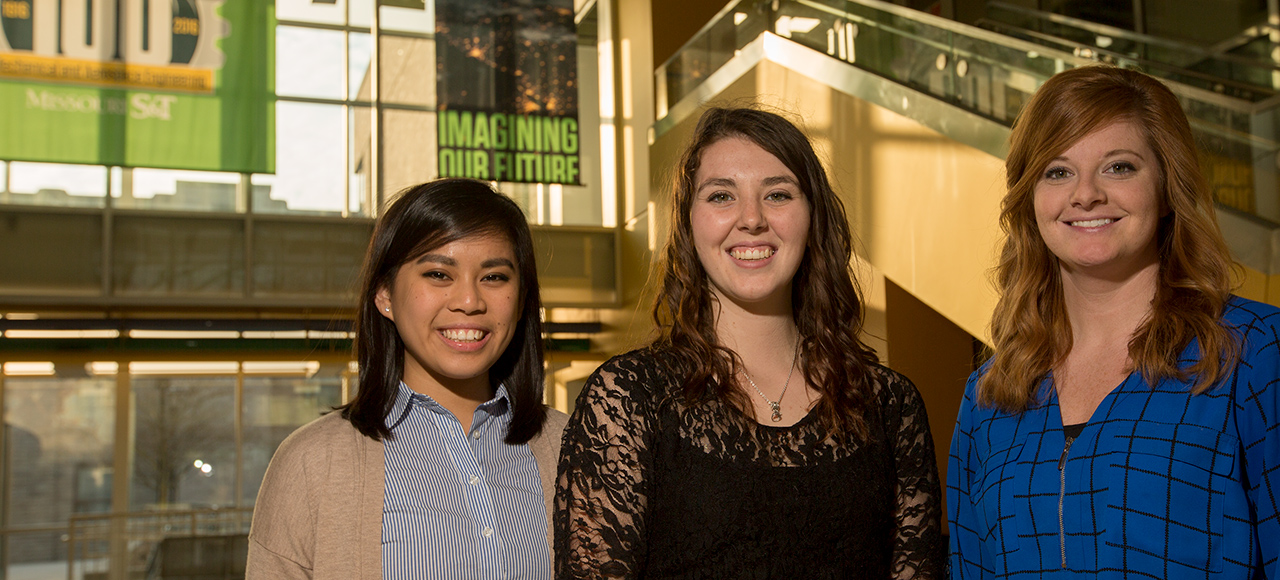Not so lost in space
Posted by Greg Katski

S&T teacher education students Frances Manahan (from left) and Marisa Tompkins and Rolla Middle School teacher Jessika Zink will attend the Space Foundation’s Space Symposium in April in Colorado Springs, Colo. Sam O’Keefe/Missouri S&T
A pair of teacher education students at Missouri S&T will blast off for the Space Foundation’s Space Symposium on April 3 in Colorado Springs, Colo., and plan to return to campus with new ideas for their future classrooms.
The Space Foundation is a global, nonprofit organization that develops space awareness activities and educational programs that bring space into the classroom and major industry events.
The students plan to incorporate what they learn at the symposium into future lesson plans.
“I’m just looking forward to the experience as a whole,” says Marisa Tompkins, a sophomore in multidisciplinary studies and elementary education and one of the two students attending the symposium. “I want to see the different ways space can be implemented into the curriculum.”
Tompkins, who plans to teach third, fourth or fifth grade, knows that if she teaches fifth grade, she’ll have to do a curriculum section on career planning. She wants to be able to tell her students that they can be anything they want, even an astronaut.
“I want to say, ‘When I was in college, I met all these astronauts. And you can be one too if you try hard enough,’” she says.
In addition to meeting NASA astronauts, Tompkins is looking forward to networking with space industry leaders and advocates.
“We’ll make career connections (at the symposium) that will never go away,” she says.
On top of attending the symposium, Frances Manahan, a junior in applied mathematics and secondary education, was selected to join the Space Foundation’s Teacher Liaison Program.
“It’s a very competitive, highly selective program,” says Dr. Kate Drowne, associate dean for academic affairs in the College of Arts, Sciences, and Business at S&T.
As a teacher liaison, Manahan will serve as an advocate for space-themed education and use Space Foundation-provided training and resources to further integrate space principles into her future classroom.
Manahan hopes to teach high school mathematics in Missouri when she graduates from S&T. Among other lessons in math and space, Manahan plans to teach about numerical models of the Solar System.
A numerical model of the Solar System is a set of mathematical equations, which, when solved, give the approximate positions of the planets as a function of time.
According to the Space Foundation, membership into the Teacher Liaison Program is life-long as long as “requirements for using and advocating for space-based education” are met. Liaisons serve as active links between the Space Foundation and their schools and school districts, and often work with other space organizations, such as NASA.
Manahan joins nearly 200 educators in the program, including Jessika Zink, a cooperating teacher in S&T’s teacher education program and fifth grade science teacher at Rolla Middle School.
Manahan and Zink were encouraged to apply for the Teacher Liaison Program by Kelly Carter, interim director of the Teacher Education Program at S&T.
“Since our program has a strong STEAM (science, technology, engineering, art and math) emphasis, this collaboration is a good fit,” says Carter.
Zink, who will also attend the upcoming symposium, says applying for the program was a “lengthy process” that included answering a variety of questions and submitting a lesson plan related to teaching space in the classroom. According to the Space Foundation, liaisons are selected based on their active promotion of space and science education. Current teacher liaisons, as well as representatives from the U.S. Air Force Academy and space industry, review the applications.
“Participating in the Space Symposium as K-12 educators is a wonderful professional development opportunity for our students,” says Carter. “As a teacher liaison, Frances will share her experience and teaching tips for secondary education students upon her return. Marisa will be representing the elementary education emphasis, and sharing the ideas she learns.”
More information about the Teacher Liaison Program and Space Symposium can be found on the Space Foundation’s website.
Leave a Reply